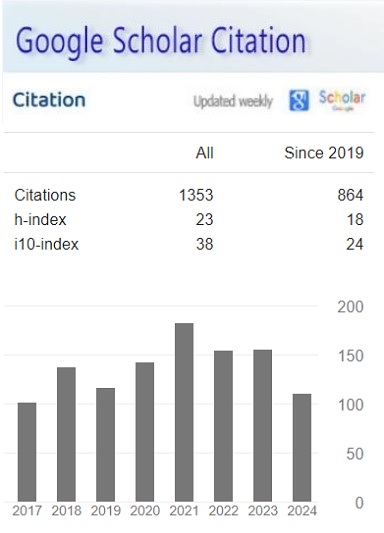Multimodal Learning Analysis via Machine Learning and Deep Learning Methodologies
Keywords:
Abstract
The world we live in is purely multimodal in nature. We can see objects, hear sounds, smell different sorts of scents, feel things, and taste various flavors. The word ‘Modality’ refers to something that occurs or something that can be experienced. An experience is presented as multimodal only when it includes some of the modalities found in the world. In order to gain recognition in understanding our general surroundings, artificial intelligence should be able to understand such multimodal perspectives. On the other hand, multimodal machine learning refers to the development of models that can interact and correlate data from various modalities. It’s a dynamic and multi-disciplinary area of expanding significance with exceptional perspective. Rather than focusing on some limited multimodal applications, we, in this paper review the new technological developments in multimodal machine learning and present them in a typical scientific categorization. We move past the usual classifications and discuss more extensive opportunities and challenges presented by multimodal machine learning. Most of the studies conducted on multimodal learning methodologies utilize polls and surveys as their primary source of collecting quantitative data. This paper discusses the results of precise literature of observational studies on the skills of multimodal data (MMD) for human learning with the help of artificial intelligence-empowered methodologies i.e. Machine Learning and Deep Learning. This paper also gives an outline of what and in what manner MMD has been leveraged to strengthen learning and in what environmental settings. The discussion of this paper portrays the abilities of multimodal learning and the continuous advances and methods that rise out of the work of multimodal learning to enhance and further elevate the learning process. At last, we conclude that future researchers should thoroughly consider developing a system that would empower multimodal features to be lined up with the ongoing research and learning plan. These features could likewise be used on enabling theory and practice activities to further elevate the multimodal learning process. This paper sets a clear pattern to enable the adoption of multimodal data inside future learning technologies and development endeavors.
References
Bynagari, N. B. (2014). Integrated Reasoning Engine for Code Clone Detection. ABC Journal of Advanced Research, 3(2), 143-152. https://doi.org/10.18034/abcjar.v3i2.575 DOI: https://doi.org/10.18034/abcjar.v3i2.575
Bynagari, N. B. (2015). Machine Learning and Artificial Intelligence in Online Fake Transaction Alerting. Engineering International, 3(2), 115-126. https://doi.org/10.18034/ei.v3i2.566 DOI: https://doi.org/10.18034/ei.v3i2.566
Bynagari, N. B. (2016). Industrial Application of Internet of Things. Asia Pacific Journal of Energy and Environment, 3(2), 75-82. https://doi.org/10.18034/apjee.v3i2.576 DOI: https://doi.org/10.18034/apjee.v3i2.576
Bynagari, N. B. (2017). Prediction of Human Population Responses to Toxic Compounds by a Collaborative Competition. Asian Journal of Humanity, Art and Literature, 4(2), 147-156. https://doi.org/10.18034/ajhal.v4i2.577 DOI: https://doi.org/10.18034/ajhal.v4i2.577
Eradze, M. & Laanpere, M. (2017). Lesson Observation Data in Learning Analytics Datasets: Observata. In Proceedings of the 12th European Conference on Technology-Enhanced Learning (EC-TEL 2017), Tallinn, Estonia, pp. 504–508. DOI: https://doi.org/10.1007/978-3-319-66610-5_50
Ganapathy, A. (2015). AI Fitness Checks, Maintenance and Monitoring on Systems Managing Content & Data: A Study on CMS World. Malaysian Journal of Medical and Biological Research, 2(2), 113-118. https://doi.org/10.18034/mjmbr.v2i2.553 DOI: https://doi.org/10.18034/mjmbr.v2i2.553
Ganapathy, A. (2016). Speech Emotion Recognition Using Deep Learning Techniques. ABC Journal of Advanced Research, 5(2), 113-122. https://doi.org/10.18034/abcjar.v5i2.550 DOI: https://doi.org/10.18034/abcjar.v5i2.550
Ganapathy, A. (2017). Friendly URLs in the CMS and Power of Global Ranking with Crawlers with Added Security. Engineering International, 5(2), 87-96. https://doi.org/10.18034/ei.v5i2.541 DOI: https://doi.org/10.18034/ei.v5i2.541
Ganapathy, A., & Neogy, T. K. (2017). Artificial Intelligence Price Emulator: A Study on Cryptocurrency. Global Disclosure of Economics and Business, 6(2), 115-122. https://doi.org/10.18034/gdeb.v6i2.558 DOI: https://doi.org/10.18034/gdeb.v6i2.558
Vadlamudi, S. (2015). Enabling Trustworthiness in Artificial Intelligence - A Detailed Discussion. Engineering International, 3(2), 105-114. https://doi.org/10.18034/ei.v3i2.519 DOI: https://doi.org/10.18034/ei.v3i2.519
Vadlamudi, S. (2016). What Impact does Internet of Things have on Project Management in Project based Firms?. Asian Business Review, 6(3), 179-186. https://doi.org/10.18034/abr.v6i3.520 DOI: https://doi.org/10.18034/abr.v6i3.520
Vadlamudi, S. (2017). Stock Market Prediction using Machine Learning: A Systematic Literature Review. American Journal of Trade and Policy, 4(3), 123-128. https://doi.org/10.18034/ajtp.v4i3.521 DOI: https://doi.org/10.18034/ajtp.v4i3.521
Downloads
Published
How to Cite
Issue
Section
License
Copyright (c) 2018 Asian Journal of Applied Science and Engineering

This work is licensed under a Creative Commons Attribution-NonCommercial 4.0 International License.








